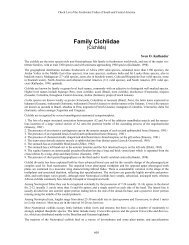Open Access PDF - Sven Kullander
Open Access PDF - Sven Kullander
Open Access PDF - Sven Kullander
You also want an ePaper? Increase the reach of your titles
YUMPU automatically turns print PDFs into web optimized ePapers that Google loves.
298<br />
rays gradually shorter. Pectoral fin rounded in<br />
juveniles, becoming acuminate in adults, with<br />
rays 4 or 5 longest; pectoral-fin rays 14-15, rarely<br />
13 or 16 (Table 8). Caudal fin with 8 + 8 = 16 principal<br />
rays; posterior margin emarginate in juveniles,<br />
truncate, subtruncate or slightly convex in<br />
adults.<br />
Supraneurals 2, vertebrae 34-37, usually 18+17,<br />
16+18, or 19+17 (Table 9), free hypurals 5. Haemal<br />
arches present on posterior abdominal centra.<br />
Lateralis canal system on head including<br />
Table 7. Absolute frequencies of number of soft anal<br />
fin rays in species of Cichla (N = 332). Modal values in<br />
bold.<br />
N 8 10 11 12 13<br />
C. ocellaris 39 6 31 2<br />
C. orinocensis 42 3 29 9 1<br />
C. nigromaculata 5 5<br />
C. monoculus 37 7 27 3<br />
C. kelberi 10 7 3<br />
C. pleiozona 14 2 9 3<br />
C. mirianae 17 11 6<br />
C. melaniae 7 1 6<br />
C. piquiti 21 1 16 4<br />
C. thyrorus 17 1 13 3<br />
C. jariina 5 5<br />
C. pinima 52 14 35 3<br />
C. vazzoleri 27 2 22 3<br />
C. temensis 33 2 29 2<br />
C. intermedia 6 1 5<br />
Table 8. Absolute frequencies of number of pectoral<br />
fin rays in species of Cichla (N = 317). Modal values in<br />
bold.<br />
N 13 14 15 16<br />
C. ocellaris 33 1 23 9<br />
C. orinocensis 36 29 7<br />
C. nigromaculata 5 5<br />
C. monoculus 37 1 31 5<br />
C. kelberi 10 2 8<br />
C. pleiozona 14 1 11 2<br />
C. mirianae 15 1 12 2<br />
C. melaniae 5 1 3 1<br />
C. piquiti 21 15 6<br />
C. thyrorus 17 1 14 2<br />
C. jariina 6 5 1<br />
C. pinima 52 18 34<br />
C. vazzoleri 27 14 13<br />
C. temensis 32 4 27 1<br />
C. intermedia 6 5 1<br />
seven preopercular and five dentary foramina;<br />
suborbital series including two contiguous lachrymal<br />
bones forming a unit with a total of 5 lateralis<br />
foramina, and five tubular infraorbitals<br />
(<strong>Kullander</strong>, 1986: figs. 13A,G).<br />
Bilateral elements of lower pharyngeal jaw<br />
separate posteriorly and extensively covered by<br />
fine teeth. A row of small tooth plates present on<br />
ceratobranchial 4. On first gill arch 7 or 8 epibranchial<br />
gill rakers, one in angle, and 12 to 20<br />
cerato- and hypobranchial rakers (Table 10), all<br />
strongly denticulate, those caudally on ceratobranchial<br />
long, gradually shorter towards arch<br />
articulations, anterior three to five becoming plate<br />
like in large specimens. Count of emerging<br />
lower limb rakers decreases with increasing SL<br />
apparently because lower rakers, especially anterior<br />
3, which attached to first hypobranchial,<br />
tend to become plate-like and not easily observed<br />
or probed on well-preserved specimens. Microbranchiospines<br />
with a few spines on exposed face<br />
(<strong>Kullander</strong>, 1986: fig. 14), present on both sides<br />
of all gill arches in adults, only externally in<br />
young.<br />
Colour pattern ontogenetically variable. Juveniles<br />
20-50 mm long develop an intermediate<br />
colour pattern consisting of three dark blotches<br />
along middle of side and a lateral band extending<br />
either caudad from posterior lateral blotch to<br />
caudal-fin base or from cleithrum to caudal-fin<br />
Table 9. Absolute frequencies of vertebral counts in<br />
species of Cichla (N = 125). Modal values in bold.<br />
abdominal/caudal total<br />
18 19<br />
N 16 17 18 16 17 18 34 35 36 37<br />
C. ocellaris 6 1 2 1 2 2 4<br />
C. orinocensis 22 4 7 9 2 4 16 2<br />
C. nigromaculata 3 1 1 1 1 2<br />
C. monoculus 13 1 6 6 1 12<br />
C. kelberi 9 1 7 1 1 7 1<br />
C. pleiozona 9 8 1 8 1<br />
C. mirianae 13 1 11 1 1 11 1<br />
C. melaniae 1 1 1<br />
C. piquiti 8 5 1 2 7 1<br />
C. thyrorus 3 3 3<br />
C. jariina 4 3 1 3 1<br />
C. pinima 12 1 9 2 1 11<br />
C. vazzoleri 5 5 5<br />
C. temensis 11 8 3 8 3<br />
C. intermedia 6 1 5 1 5<br />
<strong>Kullander</strong> & Ferreira: Review of Cichla




